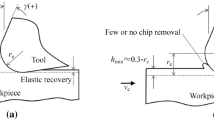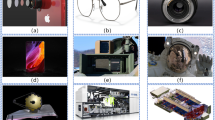Abstract
The progressive cutting based on auxiliary paths is an effective machining method for the material accumulating region inside the mould pocket. But the method is commonly based on the radial depth of cut as the control parameter, further more there is no more appropriate adjustment and control approach. The end-users often fail to set the parameter correctly, which leads to excessive tool load in the process of actual machining. In order to make more reasonable control of the machining load and tool-path, an engagement angle modeling method for multiple-circle continuous machining is presented. The distribution mode of multiple circles, dynamic changing process of engagement angle, extreme and average value of engagement angle are carefully considered. Based on the engagement angle model, numerous application techniques for mould pocket machining are presented, involving the calculation of the milling force in multiple-circle continuous machining, and rough and finish machining path planning and load control for the material accumulating region inside the pocket, and other aspects. Simulation and actual machining experiments show that the engagement angle modeling method for multiple-circle continuous machining is correct and reliable, and the related numerous application techniques for pocket machining are feasible and effective. The proposed research contributes to the analysis and control tool load effectively and tool-path planning reasonably for the material accumulating region inside the mould pocket.











Similar content being viewed by others
References
WU Shixiong, WANG Chengyong, FAN Jingming. Generate rough tool-paths from unorganized point-cloud directly[J]. Chinese Journal of Mechanical Engineering, 2007, 20(5): 1–5.
KIM B H, CHOI B K. Machining efficiency comparison direction-parallel tool path with contour-parallel tool path[J]. Computer-Aided Design, 2002, 34(2): 89–95.
DHANIK S, XIROUCHAKIS P. Contour parallel milling tool path generation for arbitrary pocket shape using a fast marching method[J]. The International Journal of Advanced Manufacturing Technology, 2010, 50(9–12): 1101–1111.
XU Kaitao, ZOU Bin, HUANG Chuanzhen, et al.Machinability of hastelloy C-276 using hot-pressed sintered Ti(C7N3)-based cermet cutting tools[J]. Chinese Journal of Mechanical Engineering, 2015, 28(3): 599–606.
LEE H U, CHO D W. An intelligent feedrate scheduling based on virtual machining[J]. The International Journal of Advanced Manufacturing Technology, 2003, 22(11–12): 873–882.
ZHAO Zhengyu, WANG Chengyong, ZHOU Houming, et al. Pocketing toolpath optimization for sharp corners[J]. Journal of Materials Processing Technology, 2007, 192: 175–180.
ZHANG Ming, LIU Weijun, Li Lun. Sharp corner clean-up CPO tool-path generating method for complex pocket[J]. Computer Integrated Manufacturing Systems, 2011, 17(11):2399–2404. (in Chinese)
BIETERMAN M B, SANDSTROM D R. A curvilinear tool-path method for pocket machining[J]. Journal of Manufacturing Science and Engineering, 2003, 125(4):709–715.
CHOY H S, CHAN K W. Enhanced strategy for milling corners[J]. Proceedings of the Institution of Mechanical Engineers, Part B: Journal of Engineering Manufacture, 2002, 216(8): 1135–1154.
CHOY H S, CHAN K W. A corner-looping based tool path for pocket milling[J]. Computer-Aided Design, 2003, 35(2): 155–166.
AN Luling, ZHOU Laishui, WANG Yuguo, et al. Tool path generation for fine milling of pocket boundary corners[J]. China Mechanical Engineering, 2005, 16(24): 2188–2192. (in Chinese)
RAHMAN A K M A, Feng H Y. Effective corner machining via a constant feed rate looping tool path[J]. International Journal of Production Research, 2013, 51(6): 1836–1851.
BANERJEE A, FENG H Y, BORDATCHEV E V. Process planning for corner machining based on a looping tool path strategy[J]. Proceedings of the Institution of Mechanical Engineers, Part B: Journal of Engineering Manufacture, 2011, 225(9): 1578–1590.
ZHOU Min, ZHENG Guolei, CHEN Shulin. Spiral looping tool-path generation for machining generalized corner residual area of pockets[J]. Journal of Computer-Aided Design & Computer Graphics, 2014, 26(9): 1536–1542. (in Chinese)
IBARAKI S, YAMAJI I, MATSUBARA A. On the removal of critical cutting regions by trochoidal grooving[J]. Precision Engineering, 2010, 34(3): 467–473.
YI Wei, JIANG Zhaoliang, SHAO Weixian, et al. Error compensation of thin plate-shape part with prebending method in face milling[J]. Chinese Journal of Mechanical Engineering, 2015, 28(1): 88–95.
CHOY H S, CHAN K W. Modeling cutter swept angle at cornering cut[J]. International Journal of CAD/CAM, 2003, 3(1): 1–12.
GAO Xin, LI Yingguang, ZHANG Chen, et al. An integrated machining tool path generation method for corner and profile of aircraft structural parts[J]. Acta Aeronautica et Astronautica Sinica, 2014, 35(9): 2660–2671. (in Chinese)
UDDIN M S, IBARAKI S, MATSUBARA A, et al. Constant engagement tool path generation to enhance machining accuracy in end milling[J]. JSME International Journal Series C, 2006, 49(1): 43–49.
OTKUR M, LAZOGLU I. Trochoidal milling[J]. International Journal of Machine Tools and Manufacture, 2007, 47(9): 1324–1332.
ALTINTAS Y, SPENCE A, TLUSTY J. End milling force algorithms for CAD systems[J]. CIRP Annals-Manufacturing Technology, 1991, 40(1): 31–34.
Author information
Authors and Affiliations
Corresponding author
Additional information
Supported by National Natural Science Foundation-Guangdong Collaborative Fund Key Program (Grant No. U12012081).
Rights and permissions
About this article
Cite this article
WU, S., MA, W., BAI, H. et al. Engagement Angle Modeling for Multiple-circle Continuous Machining and Its Application in the Pocket Machining. Chin. J. Mech. Eng. 30, 256–271 (2017). https://doi.org/10.1007/s10033-017-0092-6
Received:
Revised:
Accepted:
Published:
Issue Date:
DOI: https://doi.org/10.1007/s10033-017-0092-6




